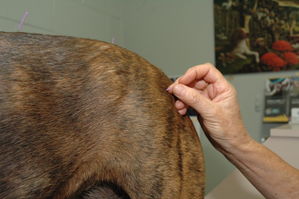After Hours
0408 512 323
Veterinary Acupuncture
A gentle, holistic approach to healing and wellness
At Eureka Veterinary Clinic, we offer veterinary acupuncture as a complementary therapy for pets with a range of chronic, painful, or functional conditions. Acupuncture is a well-established technique used to promote healing, manage pain, and improve quality of life.
What is acupuncture?
 Acupuncture involves the insertion of very fine needles into specific points on the body to stimulate a healing response. Each acupuncture point is selected based on its known effect on the body’s systems, and treatment is tailored to your pet’s individual condition.
Acupuncture involves the insertion of very fine needles into specific points on the body to stimulate a healing response. Each acupuncture point is selected based on its known effect on the body’s systems, and treatment is tailored to your pet’s individual condition.
While it has been used for thousands of years in Chinese medicine, modern veterinary acupuncture is now practiced around the world — often alongside Western medicine — and is backed by clinical research showing its effectiveness in both humans and animals.
What can acupuncture help with?
Acupuncture is especially useful for managing functional and chronic conditions, including:
Musculoskeletal and pain-related conditions:
- Arthritis and joint pain
- Intervertebral disc disease
- Nerve injuries
- Muscle tension or strain
- Recovery from sports-related injuries
Respiratory conditions:
- Feline asthma
- Chronic sinus or airway inflammation
Skin and dermatological issues:
- Lick granulomas
- Allergic dermatitis or skin inflammation
Gastrointestinal disorders:
- Diarrhoea
- Inflammatory conditions
Reproductive and behavioural issues:
- Certain fertility or cycle irregularities
- Stress-related or anxiety-linked behaviours
In addition to treating illness, regular acupuncture can support injury prevention and performance maintenance in active animals, such as working dogs or those involved in racing, agility, or showing.
What happens during a treatment?
Your pet’s first appointment will take around 45 to 60 minutes, allowing time for:
- A thorough history and physical examination
- A Traditional Chinese Medicine (TCM) diagnosis
- Development of a tailored treatment plan
Each acupuncture session typically takes 20–30 minutes. Most pets tolerate the needles very well, and many become relaxed — even sleepy — during treatment. You are welcome (and encouraged) to stay with your pet throughout their session.
The number of sessions needed will depend on your pet’s condition and response to treatment. Your vet will discuss this with you during the first consultation.
Meet our acupuncture practitioner
Acupuncture services at Eureka Vet are provided by Dr Diane Gibney, who is trained in Traditional Chinese Veterinary Medicine and brings a calm, caring approach to every session.
She is available on selected weekdays at our Creswick Road clinic.
📞 To book an acupuncture consultation for your pet, please call us on (03) 5333 5959 and speak to our friendly team.
How Does Acupuncture Work?
Although acupuncture has its roots in ancient times before modern scientific methods were available with which to study it, many important studies have been done to indicate how acupuncture works and what physiologic mechanisms are involved in its actions. Using functional MRI to examine 15 different points, the basic tenets of acupuncture have been proven. Those are that acupuncture is based upon the point selected, the method of stimulation, and the duration of stimulation. Stimulation of these points result in specific changes in the central nervous system. It was shown that acupuncture points that have pain relieving properties associated with them tend to activate specific pain-association brainstem regions.
The National Institute of Health developed a consensus statement about acupuncture and its efficacy. NIH said that there was compelling evidence that acupuncture was useful in the management of osteoarthritis and musculoskeletal pain.
In western medical terms, acupuncture can assist the body to heal itself by affecting certain physiological changes. For example, acupuncture can stimulate nerves, increase blood circulation, relieve muscle spasm, and cause the release of hormones, such as endorphins (one of the body’s pain control chemicals) and cortisol (a natural steroid). Although many of acupuncture’s physiological effects have been studied, many more are still unknown. Further research must be conducted to discover all of acupuncture’s effects and its proper uses in veterinary medicine.
How Can My Pet Benefit from Acupuncture?
The success of the treatment will vary according to the skill of the veterinarian, the condition being treated and the number and frequency of acupuncture treatments. The length and frequency of the treatments depends on the condition of the patient and the method of stimulation (dry needle, pressure, energy sources such as lasers or heat.) that is used by the veterinary acupuncturist. A simple acute problem, such as a sprain, may require only one treatment, whereas more severe or chronic ailments may need several treatments.
Acupuncture should never be administered without a proper veterinary medical diagnosis and an ongoing assessment of the patient’s condition by a registered veterinarian. This is critical because acupuncture is capable of masking pain or other clinical signs and may delay proper veterinary medical diagnosis once treatment has begun. Elimination of pain may lead to increased activity on the part of the animal, thus delaying healing or causing the original condition to worsen.
In general, acupuncture can be effectively combined with most conventional and alternative therapies. Certified Veterinary Acupuncturists have the comprehensive training, knowledge and skill to understand the interactions between different forms of treatment and to interpret the patient’s response to therapy.
Is Acupuncture Painful?
For small animals, the insertion of acupuncture needles is virtually painless. In all animals, once the needles are in place, there should be no pain. Most animals become very relaxed and may even become sleepy. Nevertheless, acupuncture treatment may cause some sensation, presumed to be those such as tingles, cramps, or numbness which can occur in humans and which may be uncomfortable to some animals. There are certain situations in which light sedation may be considered when acupuncture is being performed.
Is Acupuncture Safe for Animals?
Acupuncture is one of the safest forms of medical treatment for animals when it is administered by a properly trained veterinarian. Side effects of acupuncture are rare, but they do exist. An animal’s condition may seem worse for up to 48 hours after a treatment. Other animals become lethargic or sleepy for 24 hours. These effects are an indication that some physiological changes are developing, and they are most often followed by an improvement in the animal’s condition.
How Safe is Acupuncture?
Acupuncture should never be administered without a proper veterinary medical diagnosis and an ongoing assessment of the patient’s condition by a registered veterinarian. This is critical because acupuncture is capable of masking pain or other clinical signs and may delay proper veterinary medical diagnosis once treatment has begun. Elimination of pain may lead to increased activity on the part of the animal, thus delaying healing or causing the original condition to worsen.
In general, acupuncture can be effectively combined with most conventional and alternative therapies. Certified Veterinary Acupuncturists have the comprehensive training, knowledge and skill to understand the interactions between different forms of treatment and to interpret the patient’s response to therapy.
How Should I Choose a Veterinary Acupuncturists for My Pet?
It is important to seek the services of a properly qualified veterinary practitioner. Dr Diane Gibney gained her credentials in Traditional Chinese Veterinary Medicine and Acupuncture through the International Veterinary Acupuncture Society( IVAS) in 2005 - the only veterinary acupuncture qualification that is recognised internationally.
In most countries and states, veterinary acupuncture is considered a surgical procedure that only licensed veterinarians may legally administer to animals. A veterinarian is in the best position to properly diagnose an animal’s health problem and then to determine whether the animal is likely to benefit from an acupuncture treatment, or whether its problem requires chemical, surgical, or no intervention.
Because of the differences in anatomy, and the potential for harm if the treatments are done incorrectly, only a properly trained veterinarian should perform acupuncture on animals. The proper training for a veterinarian would include an extensive post-doctoral educational program in veterinary acupuncture. The more your veterinarian knows about traditional Chinese philosophies and the western scientific basis for acupuncture the more you can be assured that your animals will be treated properly.
CLICK HERE for available times and bookingsBOOK ONLINE >
Locations



